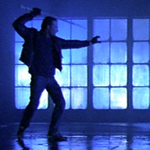
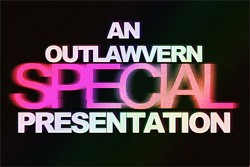 HIGHLANDER is the 1986 cult classic about immortal warriors of different nationalities waging a battle across centuries, and its opening is a clash in its own right. It starts with Sean Connery narrating flowery fantasy movie text, jumps to credits cut rhythmically to a rockin Queen theme song, and before we know it the gorgeously grainy cinematography of Gerry Fisher (WISE BLOOD, THE NINTH CONFIGURATION, DEAD BANG) and the orchestra of Michael Kamen (DEAD ZONE, BRAZIL) are lavishing cinematic glory on a super-powered sword fight between trenchcoated acquaintances in the Madison Square Garden parking garage during a professional wrestling match. The stadium rock band influenced by opera butts up against the rock arranger turned classical score composer for a sword-and-sorcery meets urban-action cage match. And somehow this all feels perfectly natural.
HIGHLANDER is the 1986 cult classic about immortal warriors of different nationalities waging a battle across centuries, and its opening is a clash in its own right. It starts with Sean Connery narrating flowery fantasy movie text, jumps to credits cut rhythmically to a rockin Queen theme song, and before we know it the gorgeously grainy cinematography of Gerry Fisher (WISE BLOOD, THE NINTH CONFIGURATION, DEAD BANG) and the orchestra of Michael Kamen (DEAD ZONE, BRAZIL) are lavishing cinematic glory on a super-powered sword fight between trenchcoated acquaintances in the Madison Square Garden parking garage during a professional wrestling match. The stadium rock band influenced by opera butts up against the rock arranger turned classical score composer for a sword-and-sorcery meets urban-action cage match. And somehow this all feels perfectly natural.
The production itself is a battle royale of nationalities: British and American financiers, Australian director Russell Mulcahy, Frenchman Christopher Lambert playing Scottish, Scotsman Connery playing Egyptian-Spanish, carrying a katana. Classes, cultures and eras fit together in unexpected ways, forming a movie that feels a little closer to the neo-noir-and-loneliness cinematography-porn of BLADE RUNNER than to other action films of ’86 like THE DELTA FORCE, AVENGING FORCE, NO RETREAT NO SURRENDER, QUIET COOL, DANGEROUSLY CLOSE or NEVER TOO YOUNG TO DIE. And yet HIGHLANDER developed enough multi-generational populist appeal to be declared “best movie ever made” by Ricky Bobby in TALLADEGA NIGHTS.

The clever premise allows the story to take place both in 16th century Scotland and 1985 New York City (with a few other stops along the way). It’s able to use sword fights and magic but also car chases and homicide investigators. Because the characters are Immortals, they’re able to sustain lots of battle damage (stabbings, bullet wounds); because the one way to kill an Immortal is to cut off his head, the movie has no choice but to show a bunch of decapitations – always a plus in an action movie. Like a Terminator or a rogue alien invader, the Immortals shock and awe all the stock characters that inhabit a 1980s movie city: punks, priests, an old lady in a bonnet, even a Vietnam vet (Christopher Malcolm, LABYRINTH) who brings a machine gun to a sword fight (and loses). These eyewitnesses not only see alley sword duels, they see a decapitated corpse levitate in the air, emanating electricity and causing shit to explode left and right. But they hate cops, so they keep their mouths shut.
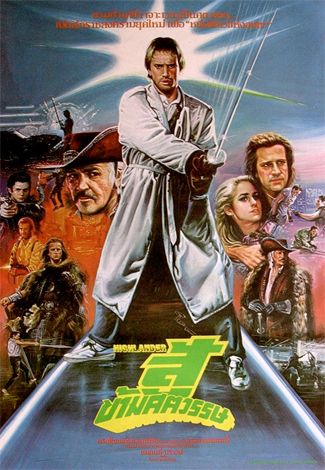 On a commentary track Mulcahy notes, “I had it rain in the car park. It makes no sense, but… it looks good.” It’s a nice summary of his cinematic philosophy, but the water actually comes from fire sprinklers, and makes sense to me. The lush, backlit style of the movie is uniquely Mulcahy. He pioneered both directing music videos (“Video Killed the Radio Star,” “Bette Davis Eyes,” “Hungry Like the Wolf,” “Total Eclipse of the Heart”) and going from videos to features. As in his first film, RAZORBACK, the director elevates an already strange genre story with meticulous attention to visuals and energetic pacing. Scenes that would be standard in other hands – an alley fight, a police raid, a sword duel in a warehouse – are vividly painted in strokes of light, smoke and color. Transitions between time periods are communicated with gimmicky wipes such as the one where the camera rises through the parking garage and the horizontal line of its ceiling becomes the plains of Scotland.
On a commentary track Mulcahy notes, “I had it rain in the car park. It makes no sense, but… it looks good.” It’s a nice summary of his cinematic philosophy, but the water actually comes from fire sprinklers, and makes sense to me. The lush, backlit style of the movie is uniquely Mulcahy. He pioneered both directing music videos (“Video Killed the Radio Star,” “Bette Davis Eyes,” “Hungry Like the Wolf,” “Total Eclipse of the Heart”) and going from videos to features. As in his first film, RAZORBACK, the director elevates an already strange genre story with meticulous attention to visuals and energetic pacing. Scenes that would be standard in other hands – an alley fight, a police raid, a sword duel in a warehouse – are vividly painted in strokes of light, smoke and color. Transitions between time periods are communicated with gimmicky wipes such as the one where the camera rises through the parking garage and the horizontal line of its ceiling becomes the plains of Scotland.
The highlands-liver of the title is Connor MacLeod (Lambert, who was known in the U.S. for GREYSTOKE, and had to learn English for the role). He was born in 1518, but we first meet him as an ’80s dude who wears a tan trenchcoat over jeans and white Diadora* sneakers. He doesn’t seem to have come to Madison Square Garden looking to fight the Immortal Iman Fasil (Peter Diamond, a.k.a. STAR WARS cantina patron Garouf Lafoe, who is also the stunt coordinator), but then was he given the tickets by mistake? Because man does he not seem to be a wrestling fan. There’s an incredible-even-for-today shot with the camera apparently hanging on wires and floating from the Jumbovision to the ring, across the crowd and up into the nosebleeds (a camera flash tries to disguise the one edit) where MacLeod seems to be the single solitary person not enjoying the show. The violence and bloodlust causes him to flash back to wars he fought in hundreds of years ago.
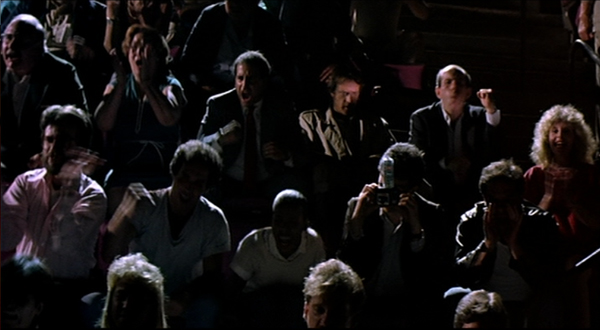
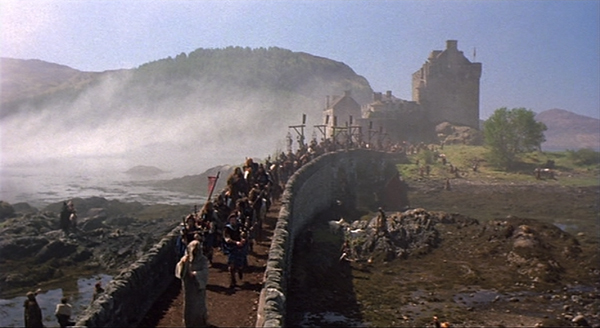
This doesn’t seem to be intentional, but I love that one of the tag teams shown are the southern-United-States-themed The Fabulous Freebirds. Here is a guy who very well may have experienced the civil war first hand, unimpressed by dumbasses waving the battle flag of the vanquished Confederacy.
Later, during a police interrogation, MacLeod mentions the wrestling being terrible. Maybe he does like wrestling but just thinks this is a poor iteration of it. He was obviously around to see Gorgeous George wrestle. And Frank Gotch. Not to mention Abraham Lincoln.
In addition to its aggressive stylishness, the beginning of this movie is unimpeachable in how it unrolls its weird mythology. Narrator Connery tells us about his people “from the dawn of time” who are “struggling to reach the time of The Gathering, when the few who remain will battle to the last.” McLeod is ready, if not thrilled, to take on this challenge with flair, even running across the tops of parked cars (just one of the ways this seems to have influenced I COME IN PEACE). I wish the action scenes weren’t so limited to one-on-one sword-clanging, but there are a few absurd touches, like when Fasil, a middle-aged-or-older gentleman in a suit and tie, does gratuitous backwards handsprings all the way from one end of the garage to the other. Strangely, these shots were removed from the 8-minutes shorter American theatrical version of the movie. And I will never forgive them for the insult.
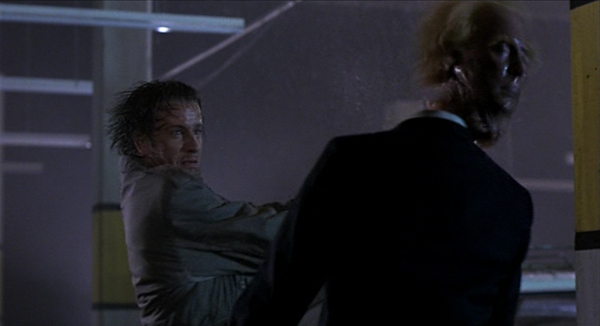
The first time you see this movie this is all pretty surprising. We’ve seen these sorts of secret battles in other extreme lifestyles, such as ninja or vampire – basically, any movie where the world you live in is just a sugar coated topping. But I personally was not prepared for the transference of power known as The Quickening. Lightning shoots from the defeated corpse to MacLeod, in the process causing the windows and headlights of all the cars in the garage to explode and rain shards everywhere. He stashes his sword and tries to drive off but is immediately surrounded by cops.
I’m sure he could escape from prison if it came down to it, but any Immortal is gonna wanna stay under the radar so as not to have to deal with this kinda shit. Unless maybe they consider it an interesting challenge, but I don’t think that’s the case with MacLeod. Anyway, it’s fun to watch this magical being get investigated by jaded (note: also homophobic) cops, including a very slim but already bald Jon Polito (MILLER’S CROSSING).
In flashbacks we learn of MacLeod’s centuries-old feud with an Immortal barbarian called The Kurgan (Clancy Brown, PET SEMATARY II) and his mentorship by the flamboyant older Immortal Juan Sanchez Villa-Lobos Ramirez (Connery, THE LEAGUE OF EXTRAORDINARY GENTLEMEN), who teaches him about decapitation, The Quickening, and the inevitable occurrence of The Gathering, when the last remaining Immortals will battle until only one remains, at which point that last will receive “The Prize.”
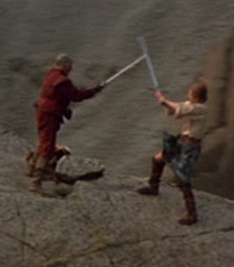 Some of the montages include Ramirez and MacLeod practicing swords on mountain tops. I was impressed that they had such cool helicopter shots of the actors sparring near dangerous ledges, and then I noticed how clearly it wasn’t them. Stunt doubles are a proud and important tradition that I’m not knocking, but I still get a laugh from that moment when I switch over from completely buying the illusion to feeling like I’m watching cosplayers. You can’t unsee it.
Some of the montages include Ramirez and MacLeod practicing swords on mountain tops. I was impressed that they had such cool helicopter shots of the actors sparring near dangerous ledges, and then I noticed how clearly it wasn’t them. Stunt doubles are a proud and important tradition that I’m not knocking, but I still get a laugh from that moment when I switch over from completely buying the illusion to feeling like I’m watching cosplayers. You can’t unsee it.
Ramirez also teaches Connor the catchphrase “There can be only one,” which will be repeated throughout the series to a numbing degree. I’m afraid the only one will not be Ramirez, though, because 1) they only had 7 days to film with him and 2) it turns out back in the day he died protecting MacLeod’s second wife Heather (Beatie Edney, IN THE NAME OF THE FATHER) from The Kurgan. So MacLeod takes it personally when that bad-guy-from-WILLOW-skull-armor-wearing motherfucker turns up in ’80s New York City in punk attire, practicing swords in a seedy hotel room, trying to pick off the last of the super old guys.
MacLeod is living as “Russell Nash,” dealer (or mostly just collector) of rare antiquities. He seems to be pretty much a loner, only close to his sole employee, Rachel Ellenstein (Sheila Gish, MANSFIELD PARK), who looks about 15 years older than him but is actually his adopted daughter who he rescued during the Holocaust (a scene indefensibly removed for the American cut). Soon he will get to know one other woman, Brenda J. Wyatt (Roxanne Hart, OH, GOD! YOU DEVIL), police forensics consultant and author of the book A Metallurgical History of Ancient Sword-Making. She finds Fasil’s sword in the parking garage, says it’s worth a million dollars, and becomes obsessed with “The Head Hunter Case” for purely sword related reasons.
“Nash” is the main suspect, but only the first victim is his. The rest come from The Kurgan, for example he duels another Immortal named Sunda Kastagir (Hugh Quarshie, a.k.a. Captain Panaka from THE PHANTOM MENACE, a.k.a. Detective Joyce from NIGHTBREED) in an alley. The aforementioned ‘Nam vet happens to be driving by and sees this. Some crazy shit to just come across. And a whole crowd gathers.
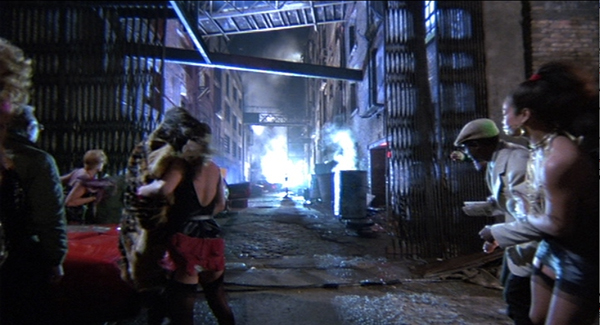
MacLeod encounters Brenda when he goes back to the garage to get his sword, and he follows her into a bar and creeps her out, so she decides to follow him, and ends up right there when the Kurgan attacks him in an alley with his giant broadsword. I like when Kurgan sarcastically grunts “Nice to see you again, MacLeod,” and MacLeod says “Nice to see yo–aggggh!” as he gets his head banged into a pipe. Like he’s just real polite and can’t stop himself from saying “Nice to see you too” even in a situation like this. They only stop fighting because a police helicopter flies over and shines a light on them.
Obviously Brenda is intrigued by this crazy shit she witnesses, so she investigates “Nash” and figures out he’s been taking the names and social security numbers of dead babies. Only one thing to do now: fall in love. But MacLeod swore off that shit hundreds of years ago – that was one of the things Ramirez taught him. So he shows her his vault of ancient artifacts and has sex with her, but the next day at the zoo he says, “Brenda, it’s not gonna work. I can’t get involved. Not again.”
(How many times has he used that line?)
So like a vampire movie there’s melodrama surrounding the heightened stakes of their romance. It works, but to me his relationship with Rachel is the moving one. He arranges to transfer all his property to her before the fight with Kurgan. “You’re not coming back, are you?” she asks. “Even if you kill him, you’re not coming back.” Her lovingly watching him leave in the elevator, tears in her eyes, is the sweetest part of the movie.
The Kurgan is a great villain partly because he either doesn’t care or doesn’t know how to blend in the way the other Immortals do. His neck got sliced and he closes it shut with safety pins. He sloppily cuts off most of his hair (like, ten times worse than Kevin Bacon in DEATH SENTENCE) and explains, “I am in disguise. This way no one will recognize me.” He approaches Connor in a church – they’re forbidden to fight on holy ground – frightens some nuns and talks loudly about raping “Ramirez’ woman,” who he then realizes was actually MacLeod’s wife. She never told him even though she lived to die of natural causes. Fucked up.
The climactic sword fight takes place partly on top of a building, a downgrade from earlier plans of The Statue of Liberty or an amusement park. During the battle they knock over the giant letters of the Silvercup logo. I assumed that was a fictional dairy company or something – turns out it was a bakery that was turned into a movie studio in 1983 and had been used for many music videos and commercials. Maybe that’s how Mulcahy knew it. Other movies that filmed scenes there include GANGS OF NEW YORK, KRUSH GROOVE and THE LAST DRAGON.
And then there’s a long finale inside the building, shot in stunning silhouette, light reflecting on a flooded floor from behind a giant wall of windows that looms over, a ticking timebomb waiting to explode from the inevitable Quickening. And Connor doesn’t flinch, he stands and enjoys a cool pose as it happens.
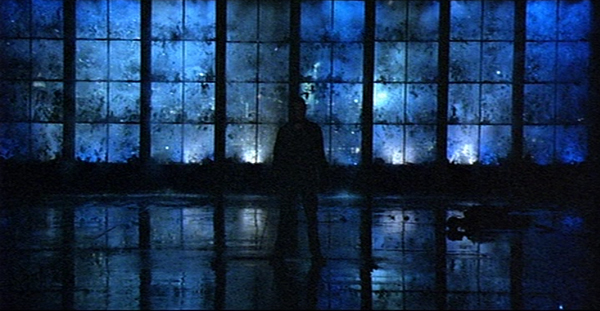
It’s a Quickening worthy of a finale because not only does it have the highest volume of shattered glass, but the energy that enters him as he receives The Prize includes these hand-animated demons or ghosts or whatever:
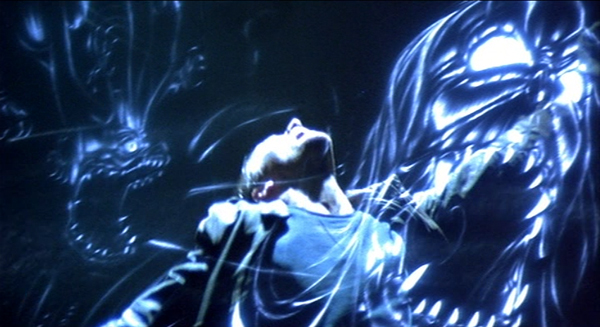
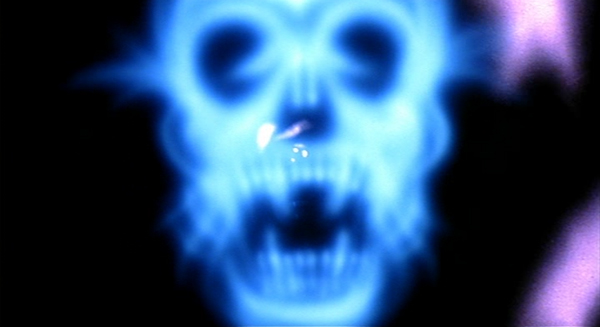
Also in that sequence is an almost subliminal shot of Connor’s head exploding. My favorite thing I discovered in this movie by pausing is this frame of an unenthused Christopher Lambert mannequin head. Maybe I’ll use it as a profile pic somewhere.
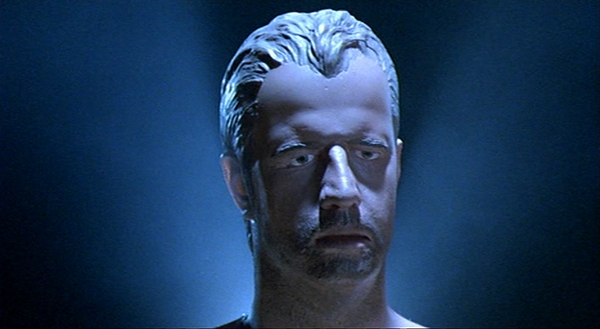
The soundtrack is an important part of the movie’s identity. Wikipedia says that the neo-prog-rock band Marillion were offered the gig first, and turned it down because they were touring. According to an interview with Money Into Light, Mulcahy knew Queen through his friend Bruce Gowers, director of the “Bohemian Rhapsody” video, and had even visited the set of FLASH GORDON (with them?). He showed them 20 minutes of footage hoping they’d give him a song, but they insisted on each band member writing one. Mulcahy stayed over at the house during the recording sessions and fondly remembers Freddie Mercury cooking him breakfast.
Queen provides not only the theme song, “Princes of the Universe,” but “Gimme the Prize (Kurgan’s Theme),” “One Year of Love,” “Don’t Lose Your Head” and the corny earworms “A Kind of Magic” and “Who Wants to Live Forever.” The latter plays in a flashback about MacLeod watching his wife Heather grow old, making it a thrillingly operatic passage. That scene was where Pixar got the idea for the movie UP [citation needed].
Instead of a soundtrack, Queen released versions of those songs on the album A Kind of Magic, named after the song named after the line from the WWII flashback not originally shown in the States. The “Princes of the Universe” video includes clips from the movie and has most of the band wearing MacLeod-style trenchcoats, performing the song on a set of the Silvercup rooftop. Lambert, in costume, joins them on stage and briefly crosses swords with Mercury. This doesn’t quite count as a HIGHLANDER concept album, though, because it has a couple unrelated songs, including “One Vision” from IRON EAGLE.
Queen is also credited for “additional music,” which I think just refers to the weird part where the Kurgan starts singing “New York, New York” and then Freddie and the boys join in non-diegetically.
The existence of multiple sequels and TV spinoffs would seem to imply that being an Immortal brings you a life of fun adventures. This first movie begs to differ. Yes, Connor MacLeod has accumulated enough resources for an incredible home stocked with centuries worth of busts and shields and things. Not hoarder shit, but priceless treasures that are also personal mementos.

He likes to sit in there and reminisce about old times, but that includes all the wars he’s fought and that time all his kinsmen (and wife!) turned on him because he survived an impalement and they thought he was a witch. Sure, it was funny when he got in that drunken duel and kept getting up after the guy stabbed him. But that doesn’t make up for the hardest lesson he learned, that he can’t fall in love. For one, because inevitably you’ll outlive her and be crushed (see: Heather MacLeod), but in his case he also puts women in danger because of his Kurgan problem (see: also Heather MacLeod). Hundreds of years later he’s still hurt by the losses of Ramirez and his “bonny.”
The Kurgan definitely does not have long term relationships. He’s a real asshole, so it’s hard to imagine he has friends of any kind. He’s also a rapist. He enjoys hookers, but I doubt they consider him a very good customer.
And think about it – if Ramirez had lived, these two bros would have to be counting down the days to when they’re the only two left and then it sounds like they’d instinctively fight each other to the death. The only people who can truly relate to your experience as an Immortal or guide you in life are also doomed to become your enemies in the end. A truly tragic existence.
That’s why it’s so perfect when we find out what “The Prize” they’re all fighting over actually is. I mean yes, there’s some sort of power where he can hear the thoughts of everyone on earth, but the main thing is that he gets to be mortal again. So he can marry Brenda and they can have kids and grow old together.
I guess now that I think about it we mortals deal with similar problems. Everybody knows they’re most likely gonna outlive their dog, cat, bird or fish, but that doesn’t stop them. So stop whining, Highlander. Apparently in earlier drafts Immortals could have children. Connor had had 37 and there was a flashback to one of his son’s funerals. That’s alot of heartbreak. I hope he appreciates being spared that by rewrites.
The script (which was at some point titled THE DARK KNIGHT) was written by undergrad/firefighter Gregory Widen as his project for the UCLA screenwriting program. The idea came to him while looking at a suit of armor on a summer vacation to Scotland. He went on to write BACKDRAFT and THE PROPHECY, so he’s probly pretty high up in the “based on characters created by” credit rankings. Rewrites were by Peter Bellwood (ST. HELENS) & Larry Ferguson (BEVERLY HILLS COP II, THE HUNT FOR RED OCTOBER, ALIEN 3, MAXIMUM RISK, ROLLERBALL).
Though I think Mulcahy’s style seems elegant after decades of Michael Bay and stuff, many at the time saw it as frantic MTV bullshit. Walter Goodman wrote in the New York Times that
“Out of this union of academic excess and pop sensibility has come a cumbersome tale told with noise and flash, and it should surprise nobody if excerpts appear on the music video channel, especially since songs by Queen are part of the hodgepodge of a score that accompanies the action.”
Washington Post critic Paul Attanasio (who later wrote QUIZ SHOW and co-created Homicide: Life on the Street) wrote:
“And in the place of THE TERMINATOR‘s sure visual panache, Russell Mulcahy has directed at a perpetual scream. The camera style is grotesquely overwrought, a relentless exercise in technique for technique’s sake. It’s all here, folks: fancy wipes, expressionistic angles, quick-cut close-ups, stylized backlighting, camera moving in endless illogic. It’s as if a 15-minute history of film technique had been compiled by a psychotic.”
Fair enough, and I’ve heard people today say that Mulcahy’s films are just cool shots without meaning or rhythm. Even if you feel that way, you’ve got to at least slightly appreciate that a series known for long-lasting middlebrow appeal, continuing largely in cheesy syndicated television and DTV sequels, could’ve started with a movie this gorgeous. There were other good looking movies in 1986, but this one stands out.
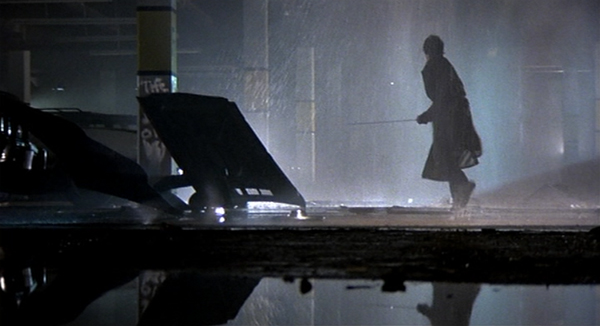

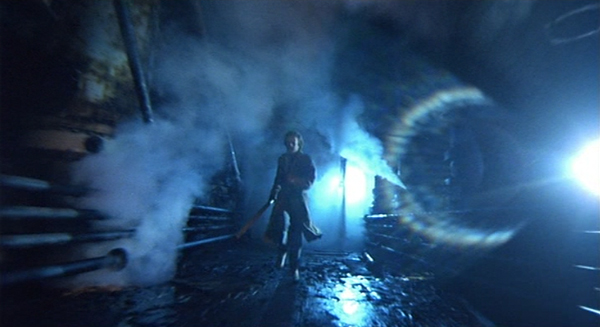
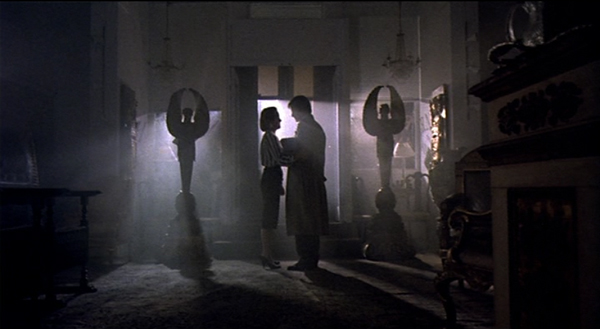
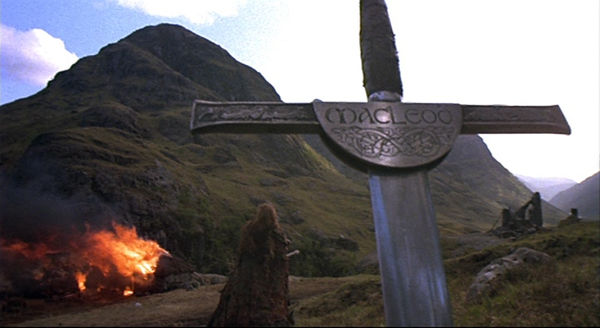
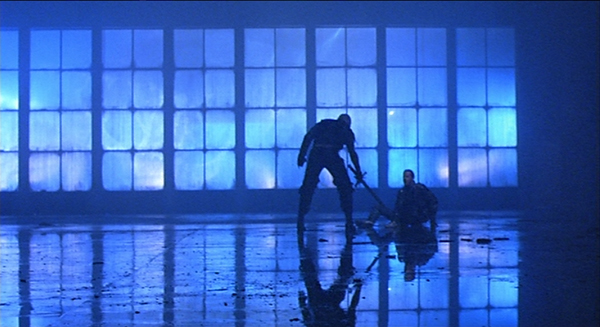
Perhaps more objectively incorrect is Attanasio’s declaration that “the fey, cartoon-faced Lambert is no action hero.” Mulcahy’s intentionally un-Rambo-like casting is a master stroke, and I’m sure Lambert would prefer he’d been less accepted as an action hero, so as to avoid typecasting. He went on to star in FORTRESS 1 and 2, GUNMEN, THE HUNTED, MORTAL KOMBAT and MEAN GUNS.
But HIGHLANDER was not an immediate hit. In its opening weekend in the U.S. it placed below PRETTY IN PINK, HOUSE, DOWN AND OUT IN BEVERLY HILLS, THE COLOR PURPLE, HANNAH AND HER SISTERS and WILDCATS, none of which were in their first week. It didn’t quite make back its $19 million budget theatrically, but it became a home video staple. And it was popular enough in Europe to create demand for a sequel, which would happen five years later and… not go smoothly. Meet me tomorrow on Planet Zeist to discuss the fairly unlikely, highly unusual followup HIGHLANDER II: THE QUICKENING.
—
*I was interested in finding out what type of shoe he was wearing, which I had guessed were Reeboks. I was happy to find that the writer of a blog called Tears of Envy had also been curious and figured it out. This is the type of thing I love about the internet. A useful post for detail weirdos like me, and surely for some cosplayers.
CONTEXT:
Other action films released in 1986:
BLACK MOON RISING, IRON EAGLE, F/X, THE DELTA FORCE, BAND OF THE HAND, DANGEROUSLY CLOSE, TOP GUN, RAW DEAL, NEVER TOO YOUNG TO DIE, BIG TROUBLE IN LITTLE CHINA, ALIENS, THE PATRIOT, AVENGING FORCE, LET’S GET HARRY, QUIET COOL, HEAT, FIREWALKER, EYE OF THE TIGER
Other fantasy films released in 1986:
THE CLAN OF THE CAVE BEAR, TROLL, LABYRINTH, THE GOLDEN CHILD
Of these, BIG TROUBLE IN LITTLE CHINA and THE GOLDEN CHILD share with HIGHLANDER the practice of fantasy in a contemporary urban setting, but both are much more comedic.
Also relevant: MANHUNTER, for its emphasis on style and music to elevate a genre story. The same could be said for BAND OF THE HAND and arguably TOP GUN.


























May 22nd, 2019 at 10:26 am
It’s funny but I think I’m pretty sure I’ve never actually watched Highlander before. I have seen the beginning because it’s proof that the Freebirds were in WWF at one point in time.